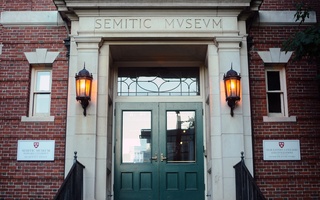“When you see the mummies, make a right.”
So said Harvard’s Philip J. King Professor of Egyptology Peter Der Manuelian ’81, as he gave directions to his office in the Semitic Musuem at 6 Divinity Avenue.
The Semitic Museum, Harvard’s showcase of Near Eastern Archaeology, is a small, cozy building nestled in between the Biological Laboratories and the Yenching Library. Upon entering, one is greeted by gleaming walls, colorful displays, and perfectly preserved pieces of ancient history of inestimable value.
Between exhibits on “The Houses in Ancient Israel,” and “Monuments from Mesopotamia,” golden statues look down with solemn gazes, while pottery and intricate metalwork shine in the slanted iridescence of sun filtering through the museum windows.
Though the contents ring of the archetypal Harvard museum, the halls feel oddly quiet.
As one of the staff members says, “We don’t get students too often.”
In 2010, Manuelian became Harvard’s first full-fledged Egyptologist on the faculty since George Andrew Reisner, class of 1889. Through his ongoing archaeological research and innovative computer modelling, Manuelian hopes to help ancient Eygypt make a comeback at Harvard and in the intellectual community at large.
A Long-Awaited Arrival
Manuelian’s office contrasts starkly with its immediate environment. In a hall of chariots, spears, and swords sits his modern room, with a digital projector, and a grapefruit-sized rotating globe sitting on the conference table. Clad in a turtle neck sweater and elbow-patch jacket, he offers a polite welcome. A book under his authorship is visible next to a desk-sized statue of one of the early pharaohs.
Previously, Manuelian served as director of the Giza Archives at the Museum of Fine Arts, Boston and as a research associate at Harvard.
When asked about what got him interested in Egyptian archaeology, Manuelian smiles reflectively.
“To me I think it was the scale of the monuments, the monumentality of the pyramids and temples, and then the fascinating hieroglyphic language structure, the very graphic and iconographic culture that uses pictures and words together to convey some pretty sophisticated thoughts,” he says. “That, and the longevity of Egyptian civilizations, three millennia or more of pharaonic culture, is a pretty impressive thing to study.”
The Egyptologist is in his fourth decade in the field. He began his archaeological career at the MFA, Boston in the summer of 1976, and began on-site work in Egypt at the Giza Pyramids in the summer of 1977. Manuelian was just out of high school.
During that year, Manuelian was part of an epigraphic expedition—meaning he continued the archiving of materials and artifacts that was not completed by an original expedition’s conclusion. He studied the tombs, their inscriptions, and the architecture of buildings around the pyramids, focusing on works that originated in the fourth dynasty in 2500 BC. After that early phase of his career, Manuelian moved on to more “traditional archaeological sites” and studied pre-dynastic work.
Unbeknownst to many, Harvard has had a long-standing association with the Giza Pyramids: the Harvard University-Boston MFA Expedition ran from 1905 until 1947 in Giza.
Read more in News
Pest Control Can Fight PovertyRecommended Articles
-
Prof. Reisner to Speak in BostonProfessor G. A. Reisner, assistant professor of Egyptology, will lecture on "Predynastic Egypt" in the lecture hall of the Boston
-
Harvard To Acquire First Egyptology Professor in DecadesAfter years dedicated to shedding light on the work of the late Harvard Egyptology Professor George A. Reisner, Class of 1889, Peter D. Manuelian ’81 will become the first egyptology professor at Harvard since his predecessor’s death 68 years ago.
-
Back to the FutureIt was in his fourth grade history class that Peter Der Manuelian ’81—Harvard’s first Egyptology professor in over 60 years—first became enamored with the splendor of ancient Egypt.
-
 A Class of Their Own
A Class of Their Own -
 Harvard Semitic Museum To Undergo New Changes
Harvard Semitic Museum To Undergo New Changes













